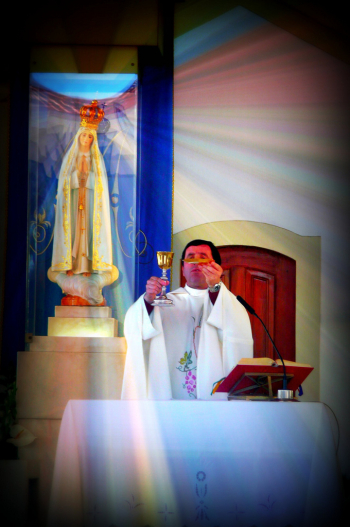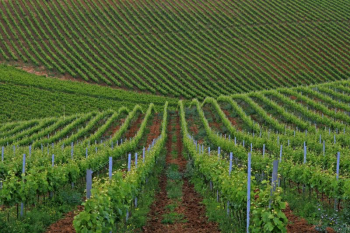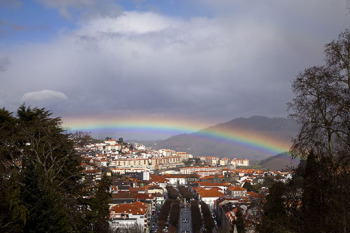by Judith Fein
[more from our SPOTLIGHT ON PORTUGAL series this week... ]
 photo by erin-thérèse via flickr (common license)Do you believe in miracles? How else can you account for what happened in a field in central Portugal on May 13, 1917, when three shepherd children saw a vision of the Virgin Mary? Purportedly, she told the awe-struck kids that she would appear at the same spot on the l3th of the five following consecutive months. According to believers, up to 70,000 witnesses beheld a miraculous apparition on the 13th day of the last month. Go to Fatima yourself to see if you are uplifted, transported, or merely interested. It’s about one and a half hours from Lisbon by train. The three children are buried in the sanctuary, and in one outdoor area the faithful light long beeswax candles that intertwine as they melt and carry prayers to heaven. Be sure to visit the museum, where Marians from around the world—including Pope John Paul—have left objects that are precious and significant to them. The latter even donated the bullet that was used by the man who tried to assassinate him. He believed that the Virgin of Fatima saved him.
photo by erin-thérèse via flickr (common license)Do you believe in miracles? How else can you account for what happened in a field in central Portugal on May 13, 1917, when three shepherd children saw a vision of the Virgin Mary? Purportedly, she told the awe-struck kids that she would appear at the same spot on the l3th of the five following consecutive months. According to believers, up to 70,000 witnesses beheld a miraculous apparition on the 13th day of the last month. Go to Fatima yourself to see if you are uplifted, transported, or merely interested. It’s about one and a half hours from Lisbon by train. The three children are buried in the sanctuary, and in one outdoor area the faithful light long beeswax candles that intertwine as they melt and carry prayers to heaven. Be sure to visit the museum, where Marians from around the world—including Pope John Paul—have left objects that are precious and significant to them. The latter even donated the bullet that was used by the man who tried to assassinate him. He believed that the Virgin of Fatima saved him.
Perhaps, while you’re in Portugal, you’ll want to find out about the secret Jews in the mountains of central Portugal who were forcibly converted to Catholicism during the Inquisition. After half a millennium of hiding their identity, they finally came out. In Belmonte, where a museum tells the story and shows the artifacts, you’ll be swept into a world where people clung to their religion in the face of great danger and, in the end, faith triumphed over oppression. There is also a synagogue, and you may be fortunate enough to meet some of the Belmonte Jews. When they decided to publicly claim their heritage and faith—about twenty years ago-- the story captivated people round the world, and now Belmonte is one of the top stops in the region for visitors of all religions.
These two destinations are good for the spirit, but what about the spirits of Portugal—the imbibable ones? My husband Paul and I knew about and had sampled fine aged, vintage port from Porto, but we knew nothing about the wines. Actually, that was one of the most significant discoveries we made: Portuguese wines have been around since Roman times, but in terms of finding their way to discerning modern palates, the sophisticated, surprising vinhos have been largely unknown outside of the country. We traveled through Portugal with international wine experts and, after sampling hundreds of wines, they unanimously declared that they didn’t taste a bad one in Portugal.
 photo by Fr AntunesThere are wine tastings throughout the country, the hillsides and plains are dotted with vineyards, and restaurants in every town and city provide the perfect ambience for experiencing the sensual delights of Portuguese wines. You only need to know three words: tinto (red), Rosado (rosé) and branco (white).
photo by Fr AntunesThere are wine tastings throughout the country, the hillsides and plains are dotted with vineyards, and restaurants in every town and city provide the perfect ambience for experiencing the sensual delights of Portuguese wines. You only need to know three words: tinto (red), Rosado (rosé) and branco (white).
Some of our favorite winemakers in the Barraida and Beira regions are:
Luis Pato http://www.luispato.com
Campolargo http://www.campolargovinhos.com/uk/
Versus: http://www.vaawines.com
Quinta de Baixo: http://quintadebaixo.pt
Be sure to visit Paco dos Cunhas de Santar to sample wines from the Dao region: http://www.visitcentro.com/en/destinations/viseu/wine-tourism/paco-dos-cunhas-de-santar/
If you go, you will find your own favorites, and you’ll probably want to carry or ship home some wines that you can savor long after your visit. It will keep the taste of the country alive on your palate and remind you of great times, great wines and the food that accompanied them.
If you can’t get to Portugal this year, the experts at your local wine store can tell you their top picks, and online sites like these offer another portal into the world of Portuguese vinhos: www.snooth.com and www.wineaccess.com
A week later, in the Douro wine-growing region, in pouring rain, I boarded a bus that snaked past terraced hills dotted with white farm manors called quintas and alit in the small town of Lamego. I went there because in the l4th century, the town was the site of a shrine to St. Esteban. In the l6th century, a church stood in its place, and devotion to St. Esteban faded out and was replaced by adoration of Our Lady of Remedies, a statue of the Virgin breastfeeding the baby Jesus. The current, little-known Baroque sanctuary dates to the l8th century and the Brotherhood of Our Lady of Remedies built a monumental stone staircase with almost 700 steps that leads from the town below to the church.
The wind blew my small umbrella inside out and I shivered from the cold and a relentless downpour as I ducked into the shrine. I followed another visitor into the sacristy behind the main altar.
There I beheld a fairly modern statue of Mary feeding her infant son. Her clothes were sky blue and salmony pink and she had an ethereal radiance and beauty that seemed to emanate from celestial realms.
On the main altar –in the heart of the church--was the older statue which gives the shrine its spiritual cache´. I had seen several Mary images in Portugal who were pregnant, but this was my first contact with breastfeeding mothers. The older Virgin seemed plainer and less idealized than the newer one. Although she was surrounded by a magnificent gilded wood sunburst, she appeared real, fleshy, small, human and accessible.
As I pondered the Lady and what she meant to her followers, two nuns walked by. I turned to ask them if they knew the date of the statue. They looked at each other uncertainly.
“I think she is from the l400’s, “ said one.
“I heard she is from the sixteenth century,” offered the other.
And then, in unison, they looked up at her and sighed.
“Isn’t she spectacular?” one asked.
“She is magnificent,” said the other.
They asked me where I came from and where I was going. When I answered, they approached me in tandem and put their hands on my arm and shoulders.
“May Our Lady bless your voyage,” one of the nuns said simply.
“May she keep you safe and out of harm’s way,” the other added.
 photo by Paul RossI nodded and headed for the exit, clutching my umbrella and zipping up my jacket. The moment I stepped outside, a full, brilliant, intense burst of color arced across the monumental staircase and embraced the town below. It was the most vivid rainbow I had ever seen, and the first time I had ever been above one.
photo by Paul RossI nodded and headed for the exit, clutching my umbrella and zipping up my jacket. The moment I stepped outside, a full, brilliant, intense burst of color arced across the monumental staircase and embraced the town below. It was the most vivid rainbow I had ever seen, and the first time I had ever been above one.
The rain stopped. There was absolute silence around me and in me. The rainbow seemed to pulsate, grow in size and for a long time maintained its dazzling intensity.
“It’s a miracle,” I muttered, wondering if, in fact, the rain had stopped and the rainbow formed because the nuns asked Our Lady to bless me.
To learn more about planning your own Portugal vacation visit www.VisitPortugal.com.
Judith Fein is an award-winning travel journalist whose articles have appeared in more than 90 publications. She co-founded and is editor of http://www.YourLifeisaTrip.com. Her NEW BOOK about transformative experiences with other cultures, LIFE IS A TRIP, is now available for pre-orders thru the Trip Shop powered by Amazon. RESERVE YOUR COPY NOW. Her website is: http://www.GlobalAdventure.us.
Like Us? Please visit our corporate sponsors:
Luxury Hotels The Kiwi Collection
Access to over 600 airport lounges worldwide with Priority Pass
Panama Hotels - Veneto Panama
Traveling to a particular country?Make the most of your trip with Lonely Planet Country Guides.
Travel Insurance: Simple & FlexibleWorldNomads.com
